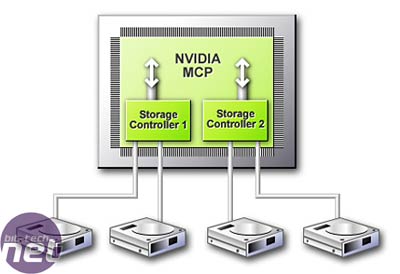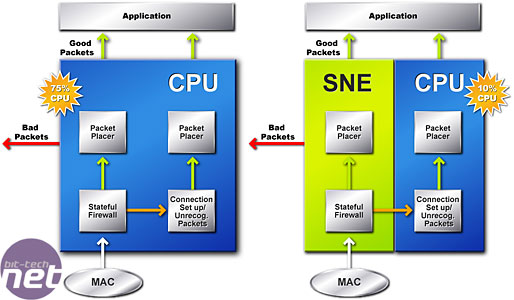NVIDIA's SLI: Part 1 - Motherboards
May 16, 2005 | 09:31

A New Disk Controller
The disk controller that was included in NForce3 250Gb was a 2/4 port SATA150 controller that also had support for a pair of ATA133 channels. NForce4 also features a brand new disk controller, built from the ground up using the next generation of SATA technology.
 SATA II, as it is known, is capable of delivering 300MB/sec of data per channel - NForce4's storage controller has dual controllers that support two channels each. That means there are four 300MB/sec channels implemented in to the NForce4 MCP - the fastest four port SATA controller to be implemented in to consumer hardware at present.
SATA II, as it is known, is capable of delivering 300MB/sec of data per channel - NForce4's storage controller has dual controllers that support two channels each. That means there are four 300MB/sec channels implemented in to the NForce4 MCP - the fastest four port SATA controller to be implemented in to consumer hardware at present.
However, there is more than meets the eye in the NForce4 storage controller. The controller has support for Command Queueing - a feature that sets Serial ATA apart from it's cousin. Command Queueing, in very simple terms, enables the controller to reorder commands that are sent to the disk to allow the storage platform to take advantage of the disk's current nature and rotational speed, thus improving performance.
The RAID controller has not changed in appearance - it still supports the same RAID 0, 1 and 0+1 arrays that were supported by the previous NForce3 250 chipset. NForce4, however, has additional functionality in the form of hot spare capabilities. Basically, when running either a RAID 1 or RAID 0+1 array, it allows you to assign a spare disk on to one of the ATA133 ports as a patch drive to help repair the damage. When one of the disks in the array fails, the controller notifies you which SATA port the faulty disk is connected to by using a visual aid that allows you to identify the disk and hot swap a replacement in. As soon as you replace the disk on the ATA133 patch drive, the software steps in to rebuild the array on the new drive. Once rebuilding is complete, the drive returns to being a spare drive that protects the RAID array. This feature cannot be used in RAID 0, as there is no fault tolerance built in to the array when it fails.
ActiveArmour

NVIDIA have also updated its firewall technology, and it now comes under a new guise, known as ActiveArmour. When combined with NVIDIA's onboard Gigabit Ethernet controller, ActiveArmour delivers full all-round protection that is not offered by any other desktop firewall solution. As both are combined together in NForce4, the firewall becomes active as soon as the network driver is loaded.
All current competing desktop firewall solutions have that period of time between when the network driver is loaded, and when the firewall is activated during Windows start up. During this time, you are susceptable to attacks from the outside world if you are not behind a hardware firewall of some description.
CPU usage has also been improved over previous revisions, with at least 90% of the work being done by the NForce4 chipset. This, coupled with the instant protection, makes NVIDIA's inbuilt firewall a very attractive solution for users who are concerned about security and the possibilities of attacks from the outside world. We might go so far as to say that NForce4 is the perfect script-kiddy platform!
What you don't get
Of course, there are some notable omissions to the spec sheet. The first is any type of onboard graphics. Whilst you wouldn't expect an SLI board to have onboard video, it would be good to have the option in the standard chipset. NVIDIA are, however, working on a chipset that will sport onboard video for the latter half of this year.
Also absent is any kind of built-in audio solution, with motherboard makers relying on third-party codecs from suppliers like Realtek or C-Media. Alas, there is no return to the heady days of NForce2 and Soundstorm.
Obviously, the last thing to mention is that this chipset only supports AMD processors. If you want to use Intel ones, you need the NForce4 for Intel Edition chipset, which we'll be covering later this week.
Let's move on to the specific motherboards we're going to be looking at today.
The disk controller that was included in NForce3 250Gb was a 2/4 port SATA150 controller that also had support for a pair of ATA133 channels. NForce4 also features a brand new disk controller, built from the ground up using the next generation of SATA technology.

However, there is more than meets the eye in the NForce4 storage controller. The controller has support for Command Queueing - a feature that sets Serial ATA apart from it's cousin. Command Queueing, in very simple terms, enables the controller to reorder commands that are sent to the disk to allow the storage platform to take advantage of the disk's current nature and rotational speed, thus improving performance.
The RAID controller has not changed in appearance - it still supports the same RAID 0, 1 and 0+1 arrays that were supported by the previous NForce3 250 chipset. NForce4, however, has additional functionality in the form of hot spare capabilities. Basically, when running either a RAID 1 or RAID 0+1 array, it allows you to assign a spare disk on to one of the ATA133 ports as a patch drive to help repair the damage. When one of the disks in the array fails, the controller notifies you which SATA port the faulty disk is connected to by using a visual aid that allows you to identify the disk and hot swap a replacement in. As soon as you replace the disk on the ATA133 patch drive, the software steps in to rebuild the array on the new drive. Once rebuilding is complete, the drive returns to being a spare drive that protects the RAID array. This feature cannot be used in RAID 0, as there is no fault tolerance built in to the array when it fails.
ActiveArmour

NVIDIA have also updated its firewall technology, and it now comes under a new guise, known as ActiveArmour. When combined with NVIDIA's onboard Gigabit Ethernet controller, ActiveArmour delivers full all-round protection that is not offered by any other desktop firewall solution. As both are combined together in NForce4, the firewall becomes active as soon as the network driver is loaded.
All current competing desktop firewall solutions have that period of time between when the network driver is loaded, and when the firewall is activated during Windows start up. During this time, you are susceptable to attacks from the outside world if you are not behind a hardware firewall of some description.
CPU usage has also been improved over previous revisions, with at least 90% of the work being done by the NForce4 chipset. This, coupled with the instant protection, makes NVIDIA's inbuilt firewall a very attractive solution for users who are concerned about security and the possibilities of attacks from the outside world. We might go so far as to say that NForce4 is the perfect script-kiddy platform!
What you don't get
Of course, there are some notable omissions to the spec sheet. The first is any type of onboard graphics. Whilst you wouldn't expect an SLI board to have onboard video, it would be good to have the option in the standard chipset. NVIDIA are, however, working on a chipset that will sport onboard video for the latter half of this year.
Also absent is any kind of built-in audio solution, with motherboard makers relying on third-party codecs from suppliers like Realtek or C-Media. Alas, there is no return to the heady days of NForce2 and Soundstorm.
Obviously, the last thing to mention is that this chipset only supports AMD processors. If you want to use Intel ones, you need the NForce4 for Intel Edition chipset, which we'll be covering later this week.
Let's move on to the specific motherboards we're going to be looking at today.

MSI MPG Velox 100R Chassis Review
October 14 2021 | 15:04





Want to comment? Please log in.